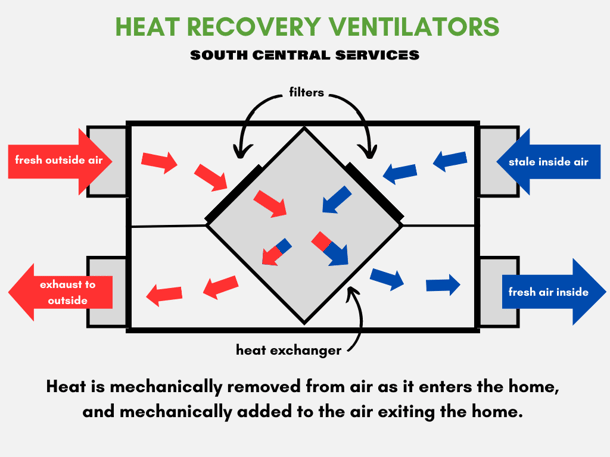How HRV Creates a Comfortable Indoor Living Environment
Exactly How Heat Recovery Ventilation Boosts Indoor Air High Quality and Reduces Power Expenses
Heat Recovery Ventilation (HRV) systems play a vital duty in enhancing interior air high quality while all at once decreasing energy expenditures. By successfully exchanging stale interior air with fresh outdoor air, HRVs aid maintain excellent humidity and minimize pollutants. Furthermore, their capacity to recuperate heat from outbound air decreases the strain on home heating and cooling down systems. As energy expenses remain to rise, comprehending the complete possibility of HRV systems becomes progressively vital for homeowners and services alike.
Recognizing Heat Recovery Ventilation Systems

Heat recovery ventilation (HRV) systems play a vital duty in boosting interior air high quality, especially in contemporary, energy-efficient buildings. These systems are developed to transfer warm from the outward bound stagnant air to the inbound fresh air, thereby reducing energy loss while preserving suitable temperature level degrees indoors. HRVs contain a warm exchanger, followers, and ductwork, facilitating the continuous circulation of air. By removing indoor contaminants and presenting fresh air, HRVs aid to stabilize moisture degrees, stop mold and mildew development, and minimize irritants. The effectiveness of HRV systems hinges on their capability to recuperate as much as 80% of the heat from the exhausted air, promoting energy preservation while guaranteeing a healthy interior environment. Their integration is crucial in attaining lasting living practices.
The Significance of Indoor Air High Quality
Indoor air quality (IAQ) is an important variable affecting the wellness and well-being of occupants in any environment. Poor IAQ can result in different health and wellness problems, consisting of breathing issues, allergic reactions, and tiredness. Furthermore, it can intensify existing conditions such as bronchial asthma. Aspects contributing to reduced IAQ consist of pollutants from interior sources like cleansing agents, mold, and insufficient ventilation. Subsequently, keeping excellent IAQ is vital for promoting a secure and comfortable living or functioning space. Efficient approaches to boost IAQ include normal tracking of air quality, proper air flow systems, and decreasing using harmful materials inside. By focusing on IAQ, people can assure a healthier environment that cultivates productivity and overall quality of life.
Energy Efficiency Conveniences of HRV Systems
Lots of property owners and building supervisors are significantly identifying the power performance benefits of heat recovery air flow (HRV) systems. By moving warm from tired indoor air to incoming fresh air, HRV systems noticeably lower the power needed for cooling and heating. This process reduces dependence on conventional heating and cooling systems, leading to reduced energy costs. In addition, HRVs help maintain a balanced interior environment, protecting against too much home heating or cooling down demands. The ability to recover up to 90% of the warmth from outward bound air likewise supports sustainability initiatives by lowering total energy intake. HRV systems add not just to set you back savings but additionally to a minimized carbon footprint, straightening with the expanding emphasis on energy-efficient structure practices.
Installment and Upkeep Considerations
The reliable execution of warm recovery air flow (HRV) systems needs mindful consideration of setup and upkeep factors to guarantee peak performance. Correct positioning of the HRV unit you can try here is important, as it should be mounted in an area that makes best use of airflow while lessening sound interruption. Additionally, ductwork must be suitably sized and protected to stop click over here now energy loss. Routine maintenance, including filter replacement and system cleansing, is essential to safeguard optimal performance and interior air top quality. Owners should develop a normal maintenance timetable to recognize and address potential problems before they rise. Partnership with experienced experts throughout both installation and maintenance phases can improve the long life and performance of HRV systems, ultimately resulting in far better interior settings and reduced energy expenses.
Real-World Applications and Success Stories
Checking out real-world applications of heat recuperation air flow (HRV) systems discloses their considerable effect on interior air quality and power effectiveness across various settings. In household structures, house owners have actually reported better air top quality, resulting in fewer allergic reactions and respiratory issues. Schools carrying out HRV systems have actually noted improved trainee concentration and minimized absenteeism because of better ventilation. Commercial structures, such as offices and retail rooms, have actually experienced lower power published here prices and raised worker efficiency. For example, a corporate workplace in a pleasant climate accomplished a 30% reduction in power expenses after setting up an HRV system. These success stories demonstrate that HRV modern technology not just contributes to healthier settings however also provides substantial monetary benefits, making it a beneficial investment for numerous markets.
Frequently Asked Inquiries
Can HRV Solutions Reduce Irritants in Indoor Air?
The efficiency of HRV systems in decreasing interior allergens primarily rests on their ability to filter and exchange air. HRV Heat Recovery Ventilation. By continually replacing stagnant air, these systems can considerably lower irritant levels throughout interior environments

Just How Does Moisture Affect HRV System Performance?
Moisture considerably influences HRV system efficiency; high degrees can bring about condensation, minimizing efficiency, while reduced humidity might improve air exchange. Balancing moisture is vital for perfect procedure and preserving interior air high quality.
Are HRV Systems Noisy Throughout Operation?
HRV systems can produce differing noise degrees during operation, depending on their style and installation. Some systems operate quietly, while others might produce recognizable noise, specifically at greater air movement setups or when improperly preserved.
What Is the Typical Lifespan of an HRV System?

Can HRV Equipments Be Made Use Of in All Environments?
HRV systems can be utilized in numerous climates, however their effectiveness may differ - HRV Heat Recovery Ventilation. In extreme temperature levels, adjustments or supplementary systems could be necessary to ensure perfect efficiency and convenience while preserving interior air quality